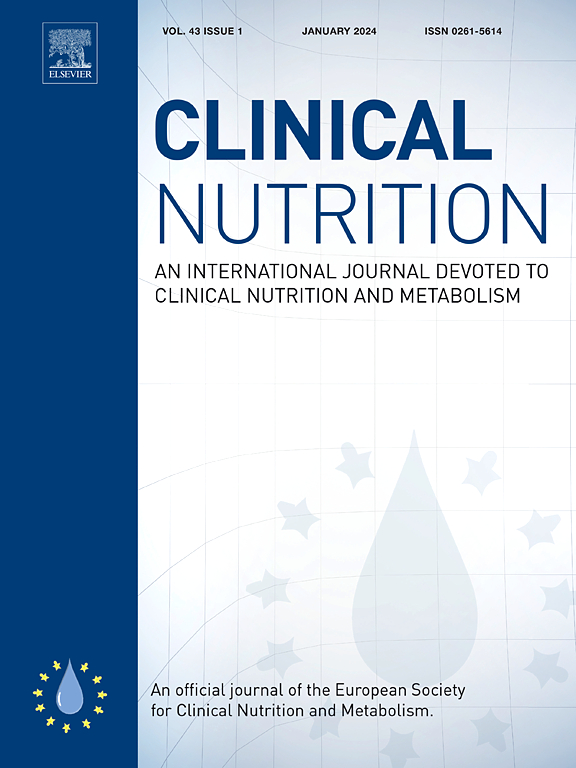Therapeutic advances in sarcopenia management: From traditional interventions to personalized medicine
IF 7.4
2区 医学
Q1 NUTRITION & DIETETICS
引用次数: 0
Abstract
Sarcopenia, a progressive decline in skeletal muscle mass and function, has emerged as a critical geriatric syndrome affecting 10–40% of older adults, contributing to increased disability and mortality. This comprehensive review evaluates evidence-based strategies for sarcopenia management, from established interventions to emerging personalized approaches. Pathophysiological insights reveal multifactorial mechanisms involving anabolic resistance, chronic inflammation (elevated IL-6, TNF-α), hormonal imbalances (e.g., testosterone/IGF-1 decline), neuromuscular junction dysfunction, mitochondrial impairment, and novel mediators like GDF-15, which drive proteolysis and appetite suppression. Non-pharmacological interventions demonstrate robust efficacy: combined resistance-aerobic exercise regimens (2–3 sessions/week) improve muscle strength by 20–35%, while optimized protein intake (1.0–1.5 g/kg/day) with leucine or vitamin D supplementation enhances muscle synthesis and functional capacity. Pharmacological trials highlight selective androgen receptor modulators (SARMs) and myostatin inhibitors (e.g., bimagrumab) increasing lean mass by 3–5% in phase II studies, with GDF-15-neutralizing antibodies emerging as promising anti-catabolic agents. Advanced therapies, including stem cell transplantation and AAV-mediated gene editing targeting myostatin/IGF-1 pathways, show preclinical regenerative potential. However, clinical translation requires validation through large-scale trials. Personalized strategies integrating biomarkers, comorbidities, and digital monitoring tools optimize intervention efficacy, particularly in complex populations like diabetic or cachectic patients. This synthesis underscores the paradigm shift toward precision medicine but identifies critical knowledge gaps, including long-term safety of biologics and cost-effectiveness of regenerative approaches. Future research should prioritize multimodal therapies, validated biomarkers, and AI-driven algorithms to individualize sarcopenia management in aging populations.
肌少症治疗的进展:从传统干预到个性化治疗
骨骼肌减少症是骨骼肌质量和功能的逐渐下降,已成为一种严重的老年综合征,影响10-40%的老年人,导致残疾和死亡率增加。这篇综合综述评估了基于证据的肌肉减少症管理策略,从既定的干预措施到新兴的个性化方法。病理生理学揭示了多因素机制,包括合成代谢抵抗,慢性炎症(IL-6升高,TNF-α),激素失衡(如睾酮/IGF-1下降),神经肌肉连接功能障碍,线粒体损伤,以及驱动蛋白质水解和食欲抑制的新型介质,如GDF-15。非药物干预显示出强大的功效:阻力-有氧联合运动方案(2-3次/周)可使肌肉力量提高20-35%,而优化蛋白质摄入量(1.0-1.5 g/kg/天)与亮氨酸或维生素D补充可增强肌肉合成和功能能力。药理学试验强调选择性雄激素受体调节剂(SARMs)和肌肉生长抑制素抑制剂(如bimagrumab)在II期研究中使瘦体重增加3-5%,gdf -15中和抗体成为有希望的抗分解代谢药物。包括干细胞移植和aav介导的靶向肌肉生长抑制素/IGF-1途径的基因编辑在内的先进疗法显示出临床前再生潜力。然而,临床翻译需要通过大规模试验进行验证。整合生物标志物、合并症和数字监测工具的个性化策略可优化干预效果,特别是在糖尿病或病毒症患者等复杂人群中。这种综合强调了向精准医学的范式转变,但也指出了关键的知识空白,包括生物制剂的长期安全性和再生方法的成本效益。未来的研究应优先考虑多模式治疗、有效的生物标志物和人工智能驱动的算法,以个性化老年人群的肌肉减少症管理。
本文章由计算机程序翻译,如有差异,请以英文原文为准。
求助全文
约1分钟内获得全文
求助全文
来源期刊

Clinical nutrition
医学-营养学
CiteScore
14.10
自引率
6.30%
发文量
356
审稿时长
28 days
期刊介绍:
Clinical Nutrition, the official journal of ESPEN, The European Society for Clinical Nutrition and Metabolism, is an international journal providing essential scientific information on nutritional and metabolic care and the relationship between nutrition and disease both in the setting of basic science and clinical practice. Published bi-monthly, each issue combines original articles and reviews providing an invaluable reference for any specialist concerned with these fields.
 求助内容:
求助内容: 应助结果提醒方式:
应助结果提醒方式:


